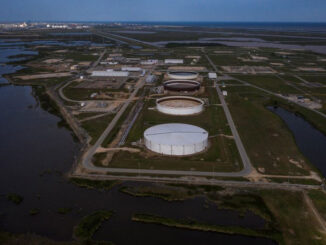
Portfolio investors continued heavy buying of crude oil futures and options for a second week after OPEC+ cut its production target more than expected.
Hedge funds and other money managers purchased the equivalent of 47 million barrels of petroleum-related futures and options in the week to Oct. 11.
Purchases came after OPEC+ announced on Oct. 5 the group would reduce its combined output target by 2 million barrels per day from November.
They followed purchases of 62 million barrels the week before as OPEC+ representatives started to brief traders on the likelihood of a large cut.
Chartbook: CFTC and ICE commitments of traders
The combined position across all six contracts has increased by 109 million barrels in the last two weeks after being cut by a total of 237 million barrels in the 16 weeks since mid-June.
In the most recent week, most buying was concentrated in crude (+36 million barrels) with heavy purchases in NYMEX and ICE WTI (+20 million) and Brent (+16 million).
There was also strong buying of middle distillates (+14 million barrels), including European gas oil (+7 million) and U.S. diesel (+6 million), but sales of U.S. gasoline (-3 million).
SHOCK AND AWE
Stemming the outflow of hedge fund money and persuading some managers to invest again was likely one of the reasons why OPEC+ cut production targets aggressively.
OPEC+ has been successful in this objective, though at the cost of fierce criticism from the United States of Saudi Arabia, the group’s de facto leader and key decision-maker.
Total hedge fund positions in crude have risen to 396 million barrels (25th percentile for all weeks since 2013) up from a low of 314 million (10th percentile) on Sept. 27.
Funds are also becoming more bullish about middle distillates as concern about low inventories and a shortage of refining capacity outweigh fears of a recession-driven downturn in demand.
The total position in mid-distillates has risen to 70 million barrels (58th percentile) from a low of 45 million (40th percentile) two weeks ago.
Bullish long positions now outnumber bearish short ones in distillates by a ratio of 4.90:1 (76th percentile) up from 2.35:1 (45th percentile).
Distillates are the most cyclically sensitive part of the oil market because most diesel and gas oil is used in manufacturing, freight transport, farming, mining and oil and gas extraction.
But fund managers have become more bullish about the outlook for distillate prices even as the economic outlook has worsened.
Global distillate inventories are at multi-decade lows and there is not enough refining capacity to replenish them unless and until a recession drives a significant downturn in consumption.
Investors appear to be betting distillate shortages will get worse in the short term before a possible recession causes them to ease later in 2023.
Related columns:
John Kemp is a Reuters market analyst. The views expressed are his own



